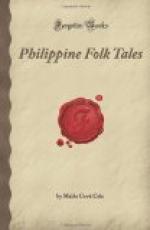With the possession of firearms, which were introduced by the newcomers, the Moro grew very daring and were greatly feared by the other natives. And soon they began to make long trips on the sea to the north and south, carrying on trade and making many surprise attacks for loot and slaves.
At the time the Spaniards discovered the Philippines, the Moro were a terror to the other inhabitants, and they continued to be so until very recent years. They became ferocious pirates infesting the southern seas and preying upon the rich trade which the Spaniards carried on with Mexico. Stone walls and watch towers were built at advantageous points to guard against them, but bays and creeks which afforded opportunities for lurking, surprise, and attack continued to be frequented by the treacherous warriors.
Since American occupation the waters have been made practically free from their ravages, but on land they have continued to give trouble. The greater part of the Moro now live in the Sulu Archipelago and on the Island of Mindanao. They range in degree of civilization from sea “gypsies,” who wander from place to place, living for months in their rude outrigger boats, to settled communities which live by fishing and farming, and even by manufacturing some cloth, brass, and steel. Their villages are near the coast, along rivers, or about the shores of the interior lakes, the houses being raised high on poles near or over the water, for they live largely on food from the sea.
Their folk-lore, as will be seen from the following tales, shows decided influence from Arabia and India, which has filtered in through the islands to the south. [140]
Mythology of Mindanao [141]
Moro
A long, long time ago Mindanao was covered with water, and the sea extended over all the lowlands so that nothing could be seen but mountains. Then there were many people living in the country, and all the highlands were dotted with villages and settlements. For many years the people prospered, living in peace and contentment. Suddenly there appeared in the land four horrible monsters which, in a short time, had devoured every human being they could find.
Kurita, a terrible creature with many limbs, lived partly on land and partly in the sea, but its favorite haunt was the mountain where the rattan grew; and here it brought utter destruction on every living thing. The second monster, Tarabusaw, an ugly creature in the form of a man, lived on Mt. Matutun, and far and wide from that place he devoured the people, laying waste the land. The third, an enormous bird called Pah, [142] was so large that when on the wing it covered the sun and brought darkness to the earth. Its egg was as large as a house. Mt. Bita was its haunt, and there the only people who escaped its voracity were those who hid in caves in the mountains. The fourth monster was a dreadful bird also, having seven heads and the power to see in all directions at the same time. Mt. Gurayn was its home and like the others it wrought havoc in its region.




